Financial Management in Organizations: A Comprehensive Analysis
VerifiedAdded on 2022/12/30
|11
|3790
|94
Report
AI Summary
This report delves into the intricacies of financial management within organizations, commencing with an examination of agency problems, particularly in the context of Morals PLC, and proposing solutions to mitigate potential conflicts of interest. The analysis extends to investment decisions, employing Net Present Value (NPV) and payback period calculations to evaluate the feasibility of a specific project, and comparing it with an alternative investment. Furthermore, the report addresses the financial challenges faced by Small and Medium Enterprises (SMEs) in securing medium to long-term finance, exploring the reasons behind these difficulties and the advantages and disadvantages of going public through an Initial Public Offering (IPO). The report also discusses the characteristics of an efficient market and the Alternative Investment Market (AIM) and various methods of flotation in the primary market.
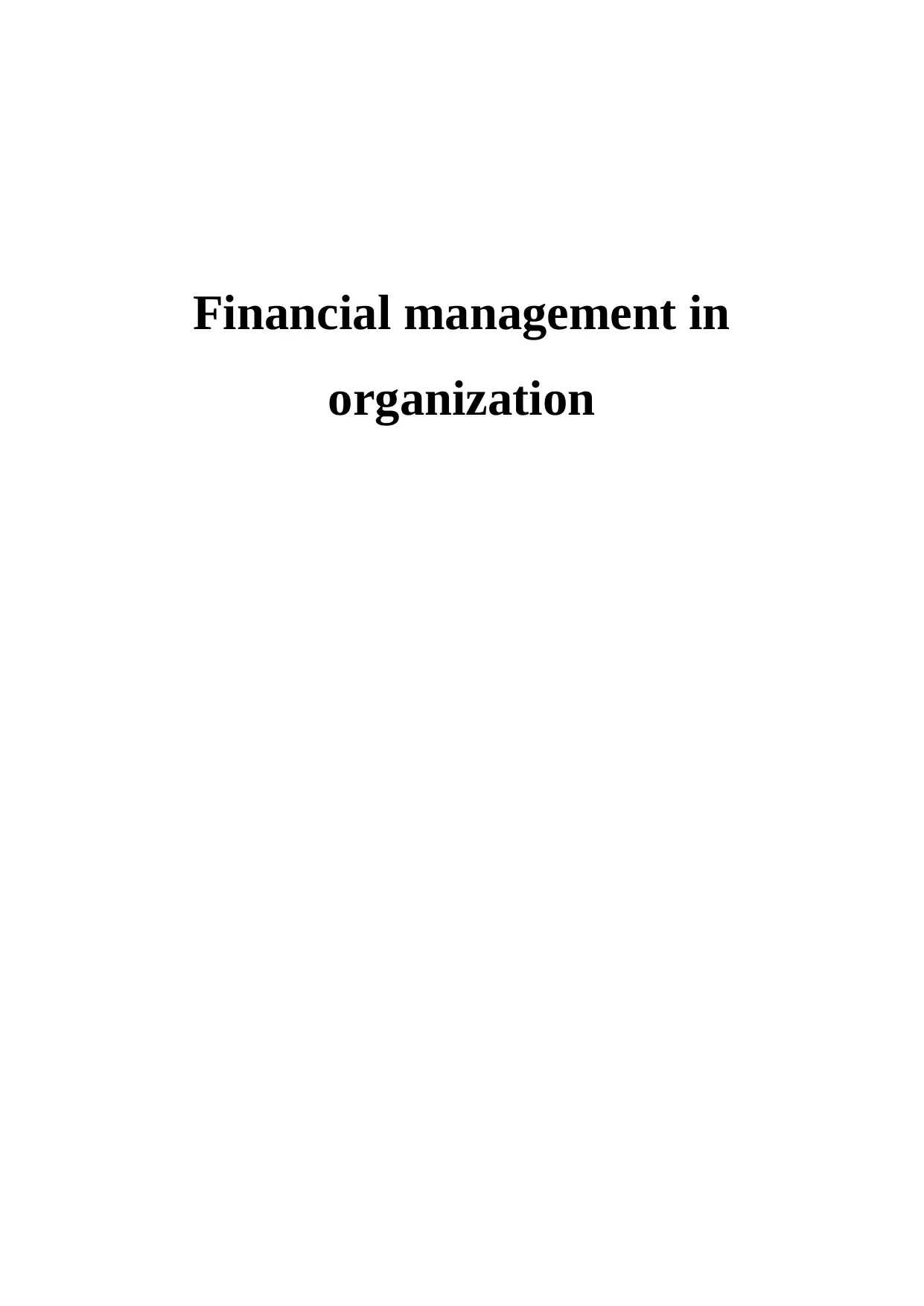
Financial management in
organization
organization
Paraphrase This Document
Need a fresh take? Get an instant paraphrase of this document with our AI Paraphraser
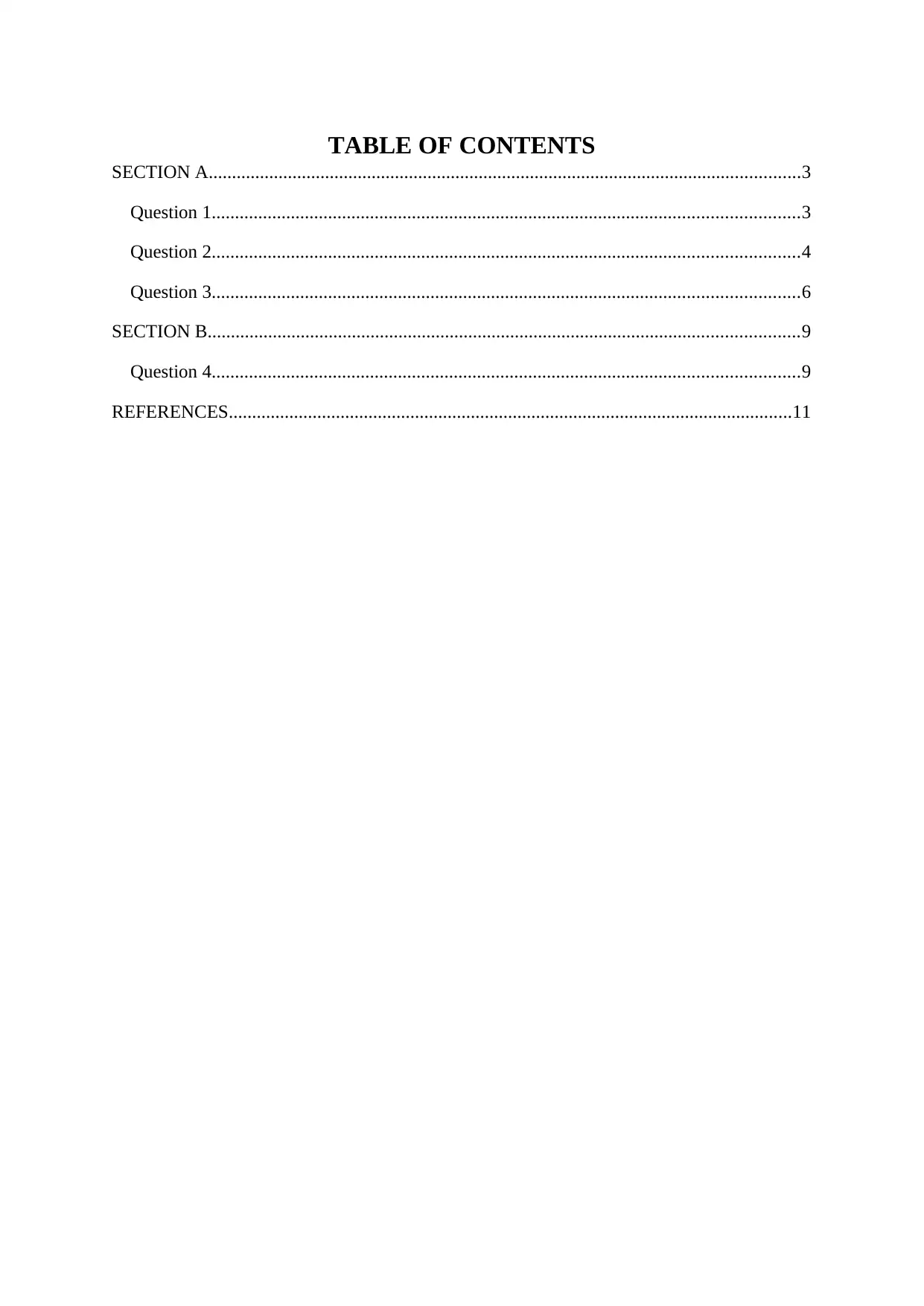
TABLE OF CONTENTS
SECTION A...............................................................................................................................3
Question 1..............................................................................................................................3
Question 2..............................................................................................................................4
Question 3..............................................................................................................................6
SECTION B...............................................................................................................................9
Question 4..............................................................................................................................9
REFERENCES.........................................................................................................................11
SECTION A...............................................................................................................................3
Question 1..............................................................................................................................3
Question 2..............................................................................................................................4
Question 3..............................................................................................................................6
SECTION B...............................................................................................................................9
Question 4..............................................................................................................................9
REFERENCES.........................................................................................................................11
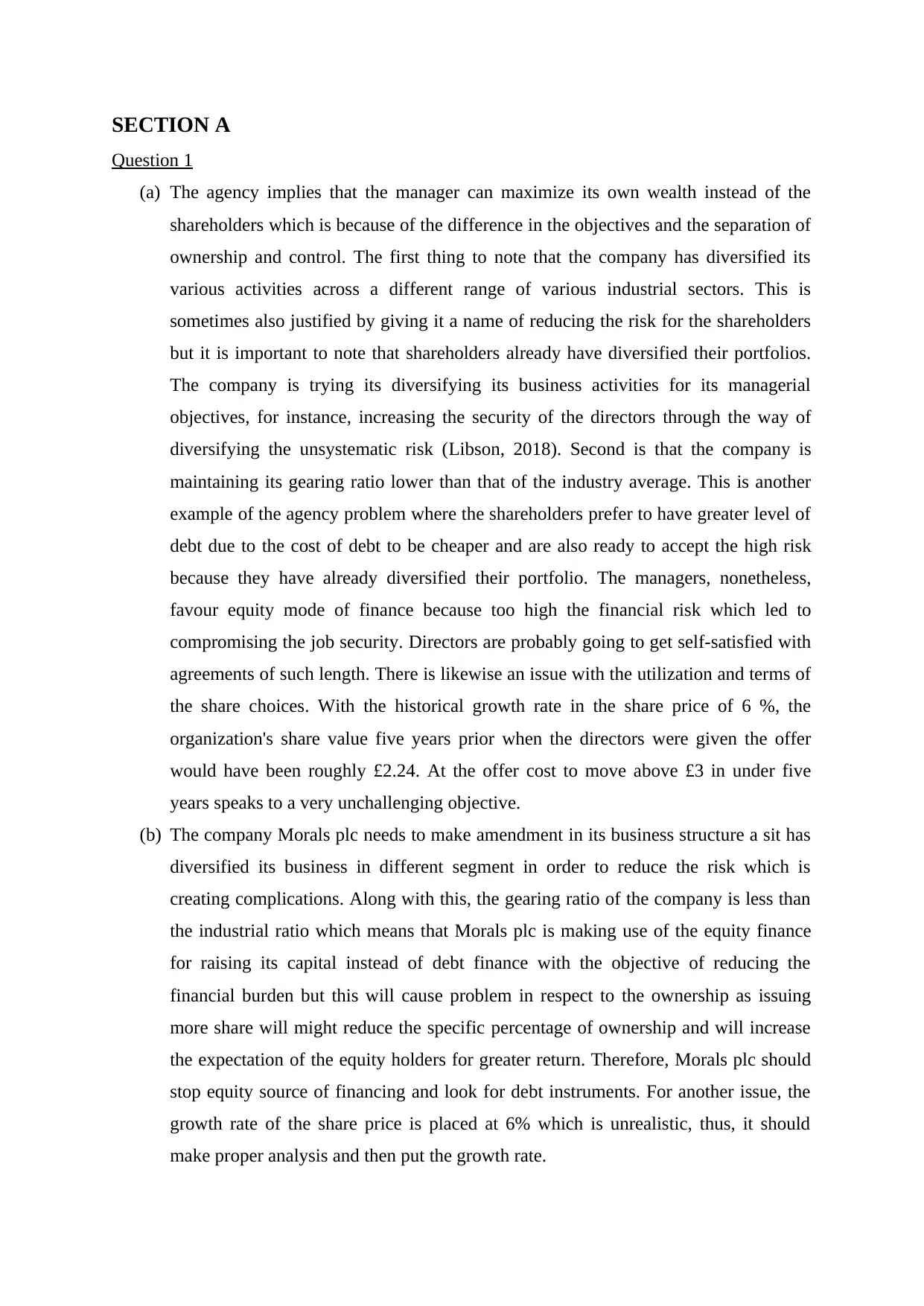
SECTION A
Question 1
(a) The agency implies that the manager can maximize its own wealth instead of the
shareholders which is because of the difference in the objectives and the separation of
ownership and control. The first thing to note that the company has diversified its
various activities across a different range of various industrial sectors. This is
sometimes also justified by giving it a name of reducing the risk for the shareholders
but it is important to note that shareholders already have diversified their portfolios.
The company is trying its diversifying its business activities for its managerial
objectives, for instance, increasing the security of the directors through the way of
diversifying the unsystematic risk (Libson, 2018). Second is that the company is
maintaining its gearing ratio lower than that of the industry average. This is another
example of the agency problem where the shareholders prefer to have greater level of
debt due to the cost of debt to be cheaper and are also ready to accept the high risk
because they have already diversified their portfolio. The managers, nonetheless,
favour equity mode of finance because too high the financial risk which led to
compromising the job security. Directors are probably going to get self-satisfied with
agreements of such length. There is likewise an issue with the utilization and terms of
the share choices. With the historical growth rate in the share price of 6 %, the
organization's share value five years prior when the directors were given the offer
would have been roughly £2.24. At the offer cost to move above £3 in under five
years speaks to a very unchallenging objective.
(b) The company Morals plc needs to make amendment in its business structure a sit has
diversified its business in different segment in order to reduce the risk which is
creating complications. Along with this, the gearing ratio of the company is less than
the industrial ratio which means that Morals plc is making use of the equity finance
for raising its capital instead of debt finance with the objective of reducing the
financial burden but this will cause problem in respect to the ownership as issuing
more share will might reduce the specific percentage of ownership and will increase
the expectation of the equity holders for greater return. Therefore, Morals plc should
stop equity source of financing and look for debt instruments. For another issue, the
growth rate of the share price is placed at 6% which is unrealistic, thus, it should
make proper analysis and then put the growth rate.
Question 1
(a) The agency implies that the manager can maximize its own wealth instead of the
shareholders which is because of the difference in the objectives and the separation of
ownership and control. The first thing to note that the company has diversified its
various activities across a different range of various industrial sectors. This is
sometimes also justified by giving it a name of reducing the risk for the shareholders
but it is important to note that shareholders already have diversified their portfolios.
The company is trying its diversifying its business activities for its managerial
objectives, for instance, increasing the security of the directors through the way of
diversifying the unsystematic risk (Libson, 2018). Second is that the company is
maintaining its gearing ratio lower than that of the industry average. This is another
example of the agency problem where the shareholders prefer to have greater level of
debt due to the cost of debt to be cheaper and are also ready to accept the high risk
because they have already diversified their portfolio. The managers, nonetheless,
favour equity mode of finance because too high the financial risk which led to
compromising the job security. Directors are probably going to get self-satisfied with
agreements of such length. There is likewise an issue with the utilization and terms of
the share choices. With the historical growth rate in the share price of 6 %, the
organization's share value five years prior when the directors were given the offer
would have been roughly £2.24. At the offer cost to move above £3 in under five
years speaks to a very unchallenging objective.
(b) The company Morals plc needs to make amendment in its business structure a sit has
diversified its business in different segment in order to reduce the risk which is
creating complications. Along with this, the gearing ratio of the company is less than
the industrial ratio which means that Morals plc is making use of the equity finance
for raising its capital instead of debt finance with the objective of reducing the
financial burden but this will cause problem in respect to the ownership as issuing
more share will might reduce the specific percentage of ownership and will increase
the expectation of the equity holders for greater return. Therefore, Morals plc should
stop equity source of financing and look for debt instruments. For another issue, the
growth rate of the share price is placed at 6% which is unrealistic, thus, it should
make proper analysis and then put the growth rate.
⊘ This is a preview!⊘
Do you want full access?
Subscribe today to unlock all pages.

Trusted by 1+ million students worldwide
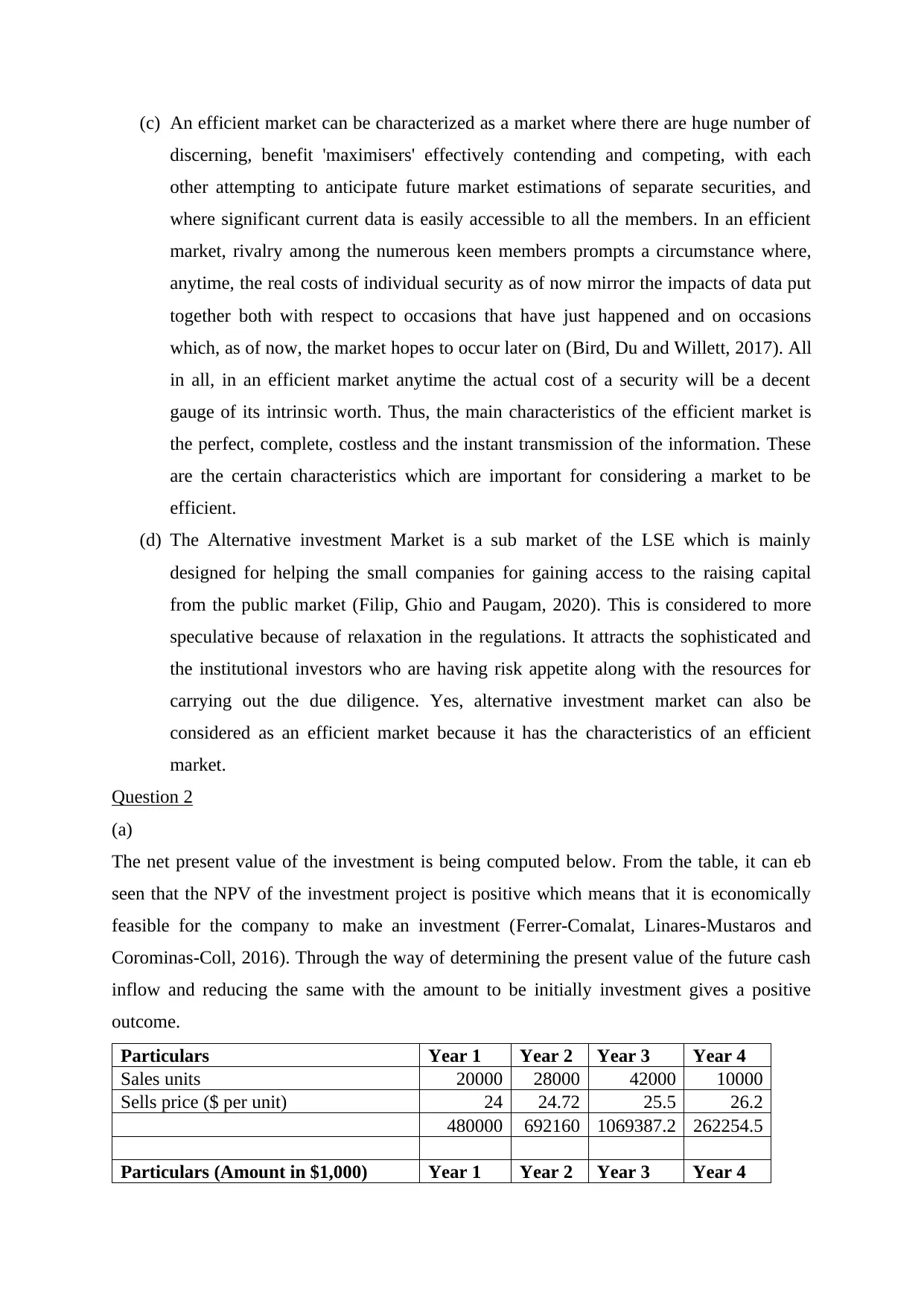
(c) An efficient market can be characterized as a market where there are huge number of
discerning, benefit 'maximisers' effectively contending and competing, with each
other attempting to anticipate future market estimations of separate securities, and
where significant current data is easily accessible to all the members. In an efficient
market, rivalry among the numerous keen members prompts a circumstance where,
anytime, the real costs of individual security as of now mirror the impacts of data put
together both with respect to occasions that have just happened and on occasions
which, as of now, the market hopes to occur later on (Bird, Du and Willett, 2017). All
in all, in an efficient market anytime the actual cost of a security will be a decent
gauge of its intrinsic worth. Thus, the main characteristics of the efficient market is
the perfect, complete, costless and the instant transmission of the information. These
are the certain characteristics which are important for considering a market to be
efficient.
(d) The Alternative investment Market is a sub market of the LSE which is mainly
designed for helping the small companies for gaining access to the raising capital
from the public market (Filip, Ghio and Paugam, 2020). This is considered to more
speculative because of relaxation in the regulations. It attracts the sophisticated and
the institutional investors who are having risk appetite along with the resources for
carrying out the due diligence. Yes, alternative investment market can also be
considered as an efficient market because it has the characteristics of an efficient
market.
Question 2
(a)
The net present value of the investment is being computed below. From the table, it can eb
seen that the NPV of the investment project is positive which means that it is economically
feasible for the company to make an investment (Ferrer-Comalat, Linares-Mustaros and
Corominas-Coll, 2016). Through the way of determining the present value of the future cash
inflow and reducing the same with the amount to be initially investment gives a positive
outcome.
Particulars Year 1 Year 2 Year 3 Year 4
Sales units 20000 28000 42000 10000
Sells price ($ per unit) 24 24.72 25.5 26.2
480000 692160 1069387.2 262254.5
Particulars (Amount in $1,000) Year 1 Year 2 Year 3 Year 4
discerning, benefit 'maximisers' effectively contending and competing, with each
other attempting to anticipate future market estimations of separate securities, and
where significant current data is easily accessible to all the members. In an efficient
market, rivalry among the numerous keen members prompts a circumstance where,
anytime, the real costs of individual security as of now mirror the impacts of data put
together both with respect to occasions that have just happened and on occasions
which, as of now, the market hopes to occur later on (Bird, Du and Willett, 2017). All
in all, in an efficient market anytime the actual cost of a security will be a decent
gauge of its intrinsic worth. Thus, the main characteristics of the efficient market is
the perfect, complete, costless and the instant transmission of the information. These
are the certain characteristics which are important for considering a market to be
efficient.
(d) The Alternative investment Market is a sub market of the LSE which is mainly
designed for helping the small companies for gaining access to the raising capital
from the public market (Filip, Ghio and Paugam, 2020). This is considered to more
speculative because of relaxation in the regulations. It attracts the sophisticated and
the institutional investors who are having risk appetite along with the resources for
carrying out the due diligence. Yes, alternative investment market can also be
considered as an efficient market because it has the characteristics of an efficient
market.
Question 2
(a)
The net present value of the investment is being computed below. From the table, it can eb
seen that the NPV of the investment project is positive which means that it is economically
feasible for the company to make an investment (Ferrer-Comalat, Linares-Mustaros and
Corominas-Coll, 2016). Through the way of determining the present value of the future cash
inflow and reducing the same with the amount to be initially investment gives a positive
outcome.
Particulars Year 1 Year 2 Year 3 Year 4
Sales units 20000 28000 42000 10000
Sells price ($ per unit) 24 24.72 25.5 26.2
480000 692160 1069387.2 262254.5
Particulars (Amount in $1,000) Year 1 Year 2 Year 3 Year 4
Paraphrase This Document
Need a fresh take? Get an instant paraphrase of this document with our AI Paraphraser
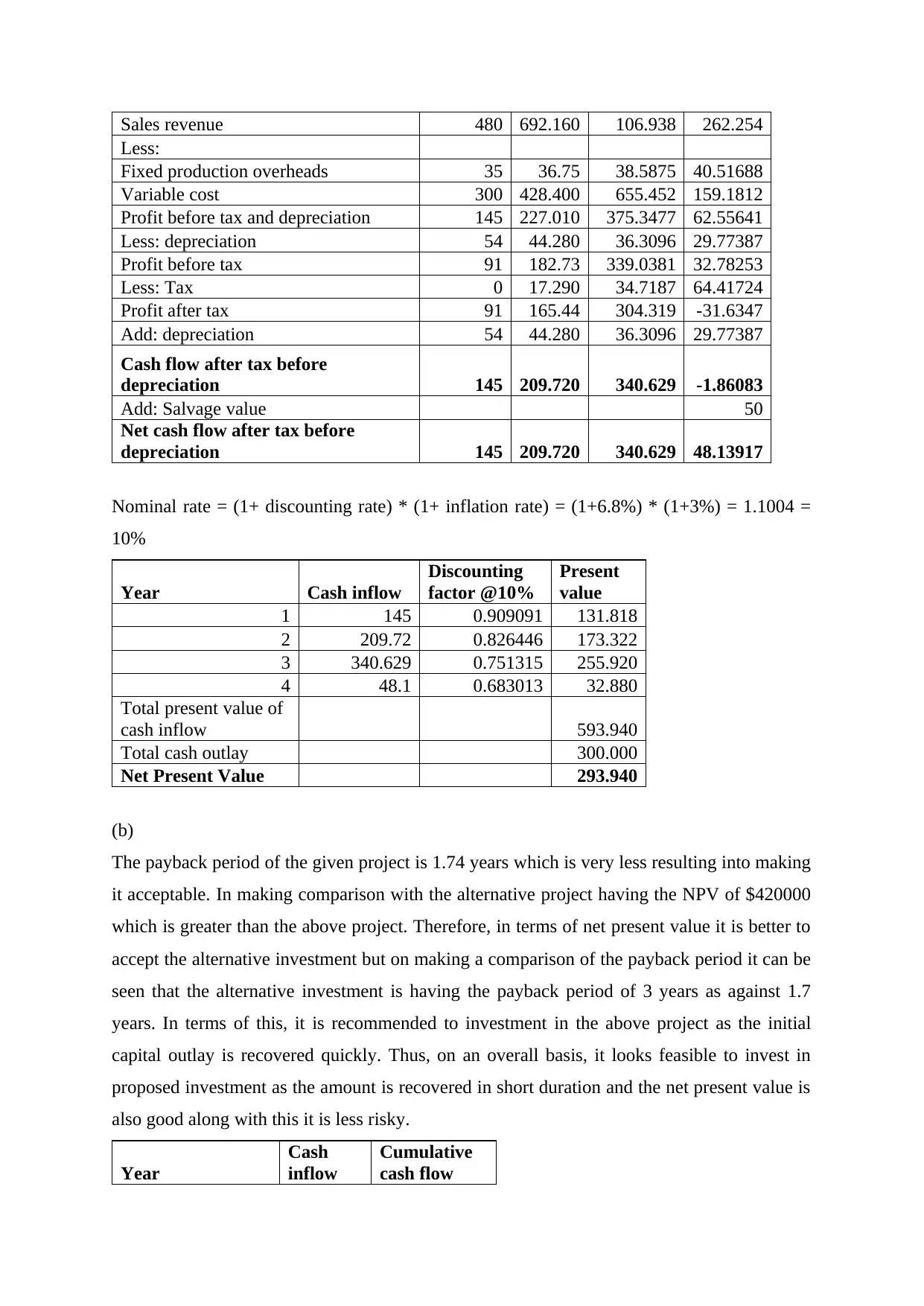
Sales revenue 480 692.160 106.938 262.254
Less:
Fixed production overheads 35 36.75 38.5875 40.51688
Variable cost 300 428.400 655.452 159.1812
Profit before tax and depreciation 145 227.010 375.3477 62.55641
Less: depreciation 54 44.280 36.3096 29.77387
Profit before tax 91 182.73 339.0381 32.78253
Less: Tax 0 17.290 34.7187 64.41724
Profit after tax 91 165.44 304.319 -31.6347
Add: depreciation 54 44.280 36.3096 29.77387
Cash flow after tax before
depreciation 145 209.720 340.629 -1.86083
Add: Salvage value 50
Net cash flow after tax before
depreciation 145 209.720 340.629 48.13917
Nominal rate = (1+ discounting rate) * (1+ inflation rate) = (1+6.8%) * (1+3%) = 1.1004 =
10%
Year Cash inflow
Discounting
factor @10%
Present
value
1 145 0.909091 131.818
2 209.72 0.826446 173.322
3 340.629 0.751315 255.920
4 48.1 0.683013 32.880
Total present value of
cash inflow 593.940
Total cash outlay 300.000
Net Present Value 293.940
(b)
The payback period of the given project is 1.74 years which is very less resulting into making
it acceptable. In making comparison with the alternative project having the NPV of $420000
which is greater than the above project. Therefore, in terms of net present value it is better to
accept the alternative investment but on making a comparison of the payback period it can be
seen that the alternative investment is having the payback period of 3 years as against 1.7
years. In terms of this, it is recommended to investment in the above project as the initial
capital outlay is recovered quickly. Thus, on an overall basis, it looks feasible to invest in
proposed investment as the amount is recovered in short duration and the net present value is
also good along with this it is less risky.
Year
Cash
inflow
Cumulative
cash flow
Less:
Fixed production overheads 35 36.75 38.5875 40.51688
Variable cost 300 428.400 655.452 159.1812
Profit before tax and depreciation 145 227.010 375.3477 62.55641
Less: depreciation 54 44.280 36.3096 29.77387
Profit before tax 91 182.73 339.0381 32.78253
Less: Tax 0 17.290 34.7187 64.41724
Profit after tax 91 165.44 304.319 -31.6347
Add: depreciation 54 44.280 36.3096 29.77387
Cash flow after tax before
depreciation 145 209.720 340.629 -1.86083
Add: Salvage value 50
Net cash flow after tax before
depreciation 145 209.720 340.629 48.13917
Nominal rate = (1+ discounting rate) * (1+ inflation rate) = (1+6.8%) * (1+3%) = 1.1004 =
10%
Year Cash inflow
Discounting
factor @10%
Present
value
1 145 0.909091 131.818
2 209.72 0.826446 173.322
3 340.629 0.751315 255.920
4 48.1 0.683013 32.880
Total present value of
cash inflow 593.940
Total cash outlay 300.000
Net Present Value 293.940
(b)
The payback period of the given project is 1.74 years which is very less resulting into making
it acceptable. In making comparison with the alternative project having the NPV of $420000
which is greater than the above project. Therefore, in terms of net present value it is better to
accept the alternative investment but on making a comparison of the payback period it can be
seen that the alternative investment is having the payback period of 3 years as against 1.7
years. In terms of this, it is recommended to investment in the above project as the initial
capital outlay is recovered quickly. Thus, on an overall basis, it looks feasible to invest in
proposed investment as the amount is recovered in short duration and the net present value is
also good along with this it is less risky.
Year
Cash
inflow
Cumulative
cash flow
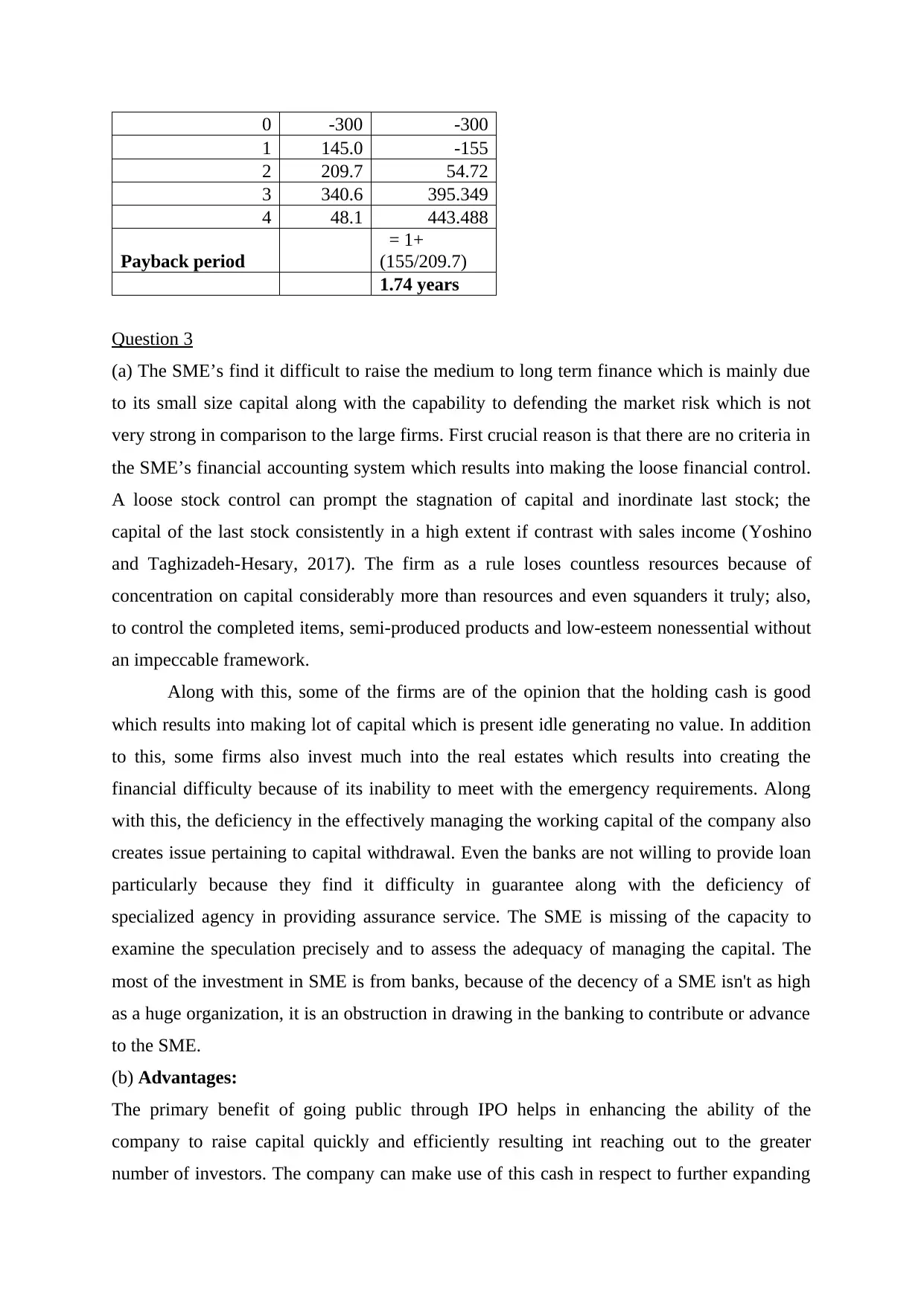
0 -300 -300
1 145.0 -155
2 209.7 54.72
3 340.6 395.349
4 48.1 443.488
Payback period
= 1+
(155/209.7)
1.74 years
Question 3
(a) The SME’s find it difficult to raise the medium to long term finance which is mainly due
to its small size capital along with the capability to defending the market risk which is not
very strong in comparison to the large firms. First crucial reason is that there are no criteria in
the SME’s financial accounting system which results into making the loose financial control.
A loose stock control can prompt the stagnation of capital and inordinate last stock; the
capital of the last stock consistently in a high extent if contrast with sales income (Yoshino
and Taghizadeh-Hesary, 2017). The firm as a rule loses countless resources because of
concentration on capital considerably more than resources and even squanders it truly; also,
to control the completed items, semi-produced products and low-esteem nonessential without
an impeccable framework.
Along with this, some of the firms are of the opinion that the holding cash is good
which results into making lot of capital which is present idle generating no value. In addition
to this, some firms also invest much into the real estates which results into creating the
financial difficulty because of its inability to meet with the emergency requirements. Along
with this, the deficiency in the effectively managing the working capital of the company also
creates issue pertaining to capital withdrawal. Even the banks are not willing to provide loan
particularly because they find it difficulty in guarantee along with the deficiency of
specialized agency in providing assurance service. The SME is missing of the capacity to
examine the speculation precisely and to assess the adequacy of managing the capital. The
most of the investment in SME is from banks, because of the decency of a SME isn't as high
as a huge organization, it is an obstruction in drawing in the banking to contribute or advance
to the SME.
(b) Advantages:
The primary benefit of going public through IPO helps in enhancing the ability of the
company to raise capital quickly and efficiently resulting int reaching out to the greater
number of investors. The company can make use of this cash in respect to further expanding
1 145.0 -155
2 209.7 54.72
3 340.6 395.349
4 48.1 443.488
Payback period
= 1+
(155/209.7)
1.74 years
Question 3
(a) The SME’s find it difficult to raise the medium to long term finance which is mainly due
to its small size capital along with the capability to defending the market risk which is not
very strong in comparison to the large firms. First crucial reason is that there are no criteria in
the SME’s financial accounting system which results into making the loose financial control.
A loose stock control can prompt the stagnation of capital and inordinate last stock; the
capital of the last stock consistently in a high extent if contrast with sales income (Yoshino
and Taghizadeh-Hesary, 2017). The firm as a rule loses countless resources because of
concentration on capital considerably more than resources and even squanders it truly; also,
to control the completed items, semi-produced products and low-esteem nonessential without
an impeccable framework.
Along with this, some of the firms are of the opinion that the holding cash is good
which results into making lot of capital which is present idle generating no value. In addition
to this, some firms also invest much into the real estates which results into creating the
financial difficulty because of its inability to meet with the emergency requirements. Along
with this, the deficiency in the effectively managing the working capital of the company also
creates issue pertaining to capital withdrawal. Even the banks are not willing to provide loan
particularly because they find it difficulty in guarantee along with the deficiency of
specialized agency in providing assurance service. The SME is missing of the capacity to
examine the speculation precisely and to assess the adequacy of managing the capital. The
most of the investment in SME is from banks, because of the decency of a SME isn't as high
as a huge organization, it is an obstruction in drawing in the banking to contribute or advance
to the SME.
(b) Advantages:
The primary benefit of going public through IPO helps in enhancing the ability of the
company to raise capital quickly and efficiently resulting int reaching out to the greater
number of investors. The company can make use of this cash in respect to further expanding
⊘ This is a preview!⊘
Do you want full access?
Subscribe today to unlock all pages.

Trusted by 1+ million students worldwide
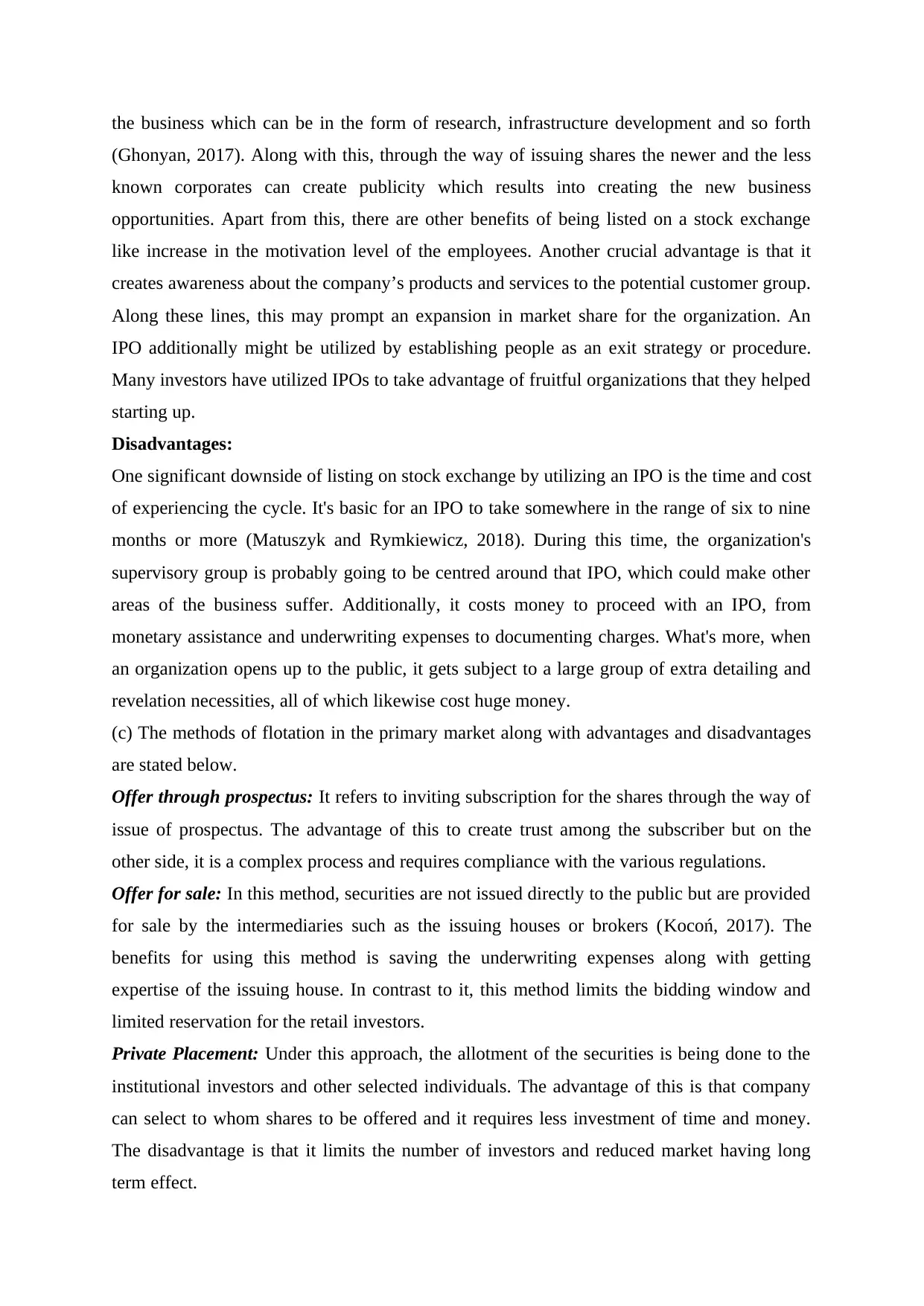
the business which can be in the form of research, infrastructure development and so forth
(Ghonyan, 2017). Along with this, through the way of issuing shares the newer and the less
known corporates can create publicity which results into creating the new business
opportunities. Apart from this, there are other benefits of being listed on a stock exchange
like increase in the motivation level of the employees. Another crucial advantage is that it
creates awareness about the company’s products and services to the potential customer group.
Along these lines, this may prompt an expansion in market share for the organization. An
IPO additionally might be utilized by establishing people as an exit strategy or procedure.
Many investors have utilized IPOs to take advantage of fruitful organizations that they helped
starting up.
Disadvantages:
One significant downside of listing on stock exchange by utilizing an IPO is the time and cost
of experiencing the cycle. It's basic for an IPO to take somewhere in the range of six to nine
months or more (Matuszyk and Rymkiewicz, 2018). During this time, the organization's
supervisory group is probably going to be centred around that IPO, which could make other
areas of the business suffer. Additionally, it costs money to proceed with an IPO, from
monetary assistance and underwriting expenses to documenting charges. What's more, when
an organization opens up to the public, it gets subject to a large group of extra detailing and
revelation necessities, all of which likewise cost huge money.
(c) The methods of flotation in the primary market along with advantages and disadvantages
are stated below.
Offer through prospectus: It refers to inviting subscription for the shares through the way of
issue of prospectus. The advantage of this to create trust among the subscriber but on the
other side, it is a complex process and requires compliance with the various regulations.
Offer for sale: In this method, securities are not issued directly to the public but are provided
for sale by the intermediaries such as the issuing houses or brokers (Kocoń, 2017). The
benefits for using this method is saving the underwriting expenses along with getting
expertise of the issuing house. In contrast to it, this method limits the bidding window and
limited reservation for the retail investors.
Private Placement: Under this approach, the allotment of the securities is being done to the
institutional investors and other selected individuals. The advantage of this is that company
can select to whom shares to be offered and it requires less investment of time and money.
The disadvantage is that it limits the number of investors and reduced market having long
term effect.
(Ghonyan, 2017). Along with this, through the way of issuing shares the newer and the less
known corporates can create publicity which results into creating the new business
opportunities. Apart from this, there are other benefits of being listed on a stock exchange
like increase in the motivation level of the employees. Another crucial advantage is that it
creates awareness about the company’s products and services to the potential customer group.
Along these lines, this may prompt an expansion in market share for the organization. An
IPO additionally might be utilized by establishing people as an exit strategy or procedure.
Many investors have utilized IPOs to take advantage of fruitful organizations that they helped
starting up.
Disadvantages:
One significant downside of listing on stock exchange by utilizing an IPO is the time and cost
of experiencing the cycle. It's basic for an IPO to take somewhere in the range of six to nine
months or more (Matuszyk and Rymkiewicz, 2018). During this time, the organization's
supervisory group is probably going to be centred around that IPO, which could make other
areas of the business suffer. Additionally, it costs money to proceed with an IPO, from
monetary assistance and underwriting expenses to documenting charges. What's more, when
an organization opens up to the public, it gets subject to a large group of extra detailing and
revelation necessities, all of which likewise cost huge money.
(c) The methods of flotation in the primary market along with advantages and disadvantages
are stated below.
Offer through prospectus: It refers to inviting subscription for the shares through the way of
issue of prospectus. The advantage of this to create trust among the subscriber but on the
other side, it is a complex process and requires compliance with the various regulations.
Offer for sale: In this method, securities are not issued directly to the public but are provided
for sale by the intermediaries such as the issuing houses or brokers (Kocoń, 2017). The
benefits for using this method is saving the underwriting expenses along with getting
expertise of the issuing house. In contrast to it, this method limits the bidding window and
limited reservation for the retail investors.
Private Placement: Under this approach, the allotment of the securities is being done to the
institutional investors and other selected individuals. The advantage of this is that company
can select to whom shares to be offered and it requires less investment of time and money.
The disadvantage is that it limits the number of investors and reduced market having long
term effect.
Paraphrase This Document
Need a fresh take? Get an instant paraphrase of this document with our AI Paraphraser
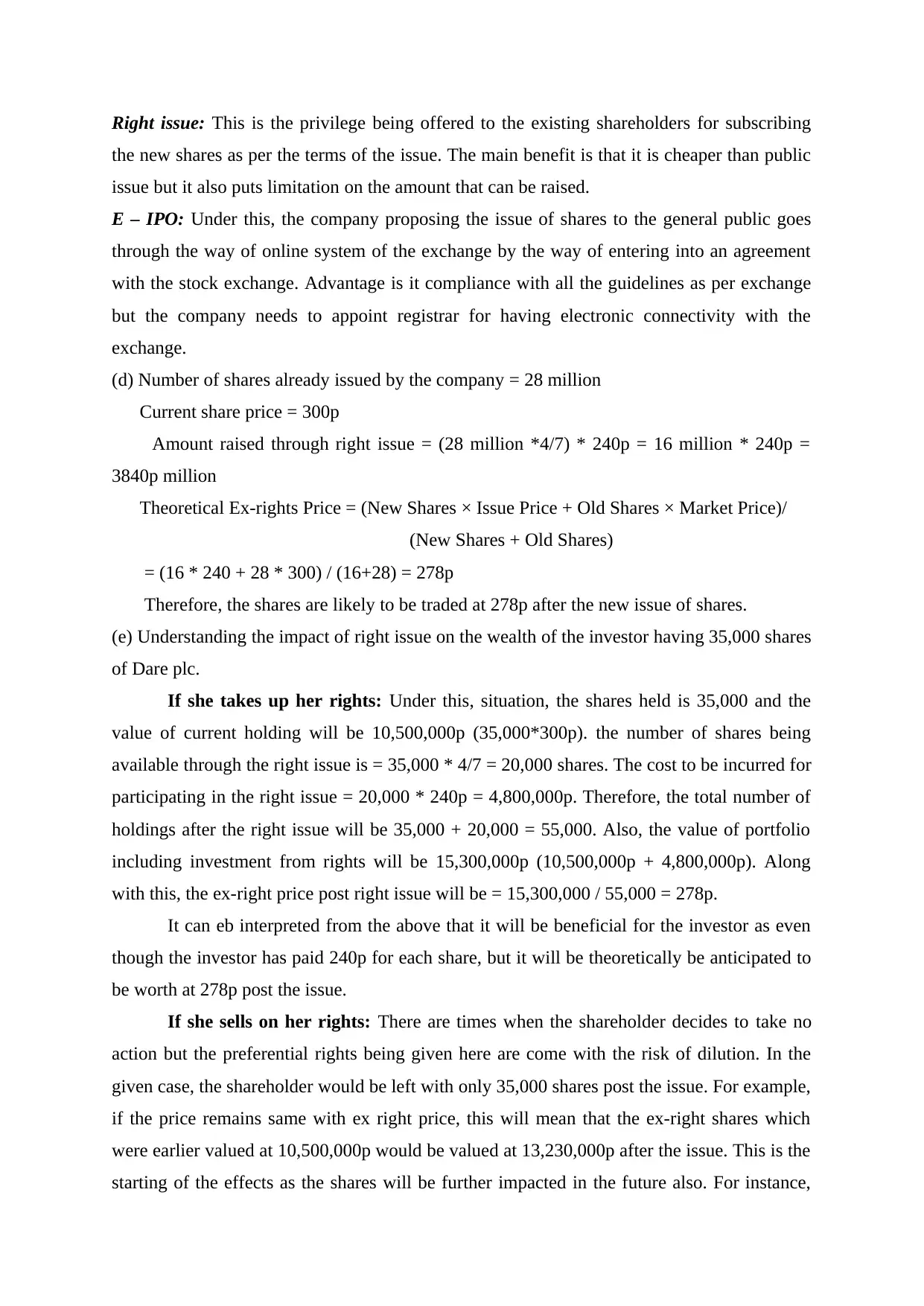
Right issue: This is the privilege being offered to the existing shareholders for subscribing
the new shares as per the terms of the issue. The main benefit is that it is cheaper than public
issue but it also puts limitation on the amount that can be raised.
E – IPO: Under this, the company proposing the issue of shares to the general public goes
through the way of online system of the exchange by the way of entering into an agreement
with the stock exchange. Advantage is it compliance with all the guidelines as per exchange
but the company needs to appoint registrar for having electronic connectivity with the
exchange.
(d) Number of shares already issued by the company = 28 million
Current share price = 300p
Amount raised through right issue = (28 million *4/7) * 240p = 16 million * 240p =
3840p million
Theoretical Ex-rights Price = (New Shares × Issue Price + Old Shares × Market Price)/
(New Shares + Old Shares)
= (16 * 240 + 28 * 300) / (16+28) = 278p
Therefore, the shares are likely to be traded at 278p after the new issue of shares.
(e) Understanding the impact of right issue on the wealth of the investor having 35,000 shares
of Dare plc.
If she takes up her rights: Under this, situation, the shares held is 35,000 and the
value of current holding will be 10,500,000p (35,000*300p). the number of shares being
available through the right issue is = 35,000 * 4/7 = 20,000 shares. The cost to be incurred for
participating in the right issue = 20,000 * 240p = 4,800,000p. Therefore, the total number of
holdings after the right issue will be 35,000 + 20,000 = 55,000. Also, the value of portfolio
including investment from rights will be 15,300,000p (10,500,000p + 4,800,000p). Along
with this, the ex-right price post right issue will be = 15,300,000 / 55,000 = 278p.
It can eb interpreted from the above that it will be beneficial for the investor as even
though the investor has paid 240p for each share, but it will be theoretically be anticipated to
be worth at 278p post the issue.
If she sells on her rights: There are times when the shareholder decides to take no
action but the preferential rights being given here are come with the risk of dilution. In the
given case, the shareholder would be left with only 35,000 shares post the issue. For example,
if the price remains same with ex right price, this will mean that the ex-right shares which
were earlier valued at 10,500,000p would be valued at 13,230,000p after the issue. This is the
starting of the effects as the shares will be further impacted in the future also. For instance,
the new shares as per the terms of the issue. The main benefit is that it is cheaper than public
issue but it also puts limitation on the amount that can be raised.
E – IPO: Under this, the company proposing the issue of shares to the general public goes
through the way of online system of the exchange by the way of entering into an agreement
with the stock exchange. Advantage is it compliance with all the guidelines as per exchange
but the company needs to appoint registrar for having electronic connectivity with the
exchange.
(d) Number of shares already issued by the company = 28 million
Current share price = 300p
Amount raised through right issue = (28 million *4/7) * 240p = 16 million * 240p =
3840p million
Theoretical Ex-rights Price = (New Shares × Issue Price + Old Shares × Market Price)/
(New Shares + Old Shares)
= (16 * 240 + 28 * 300) / (16+28) = 278p
Therefore, the shares are likely to be traded at 278p after the new issue of shares.
(e) Understanding the impact of right issue on the wealth of the investor having 35,000 shares
of Dare plc.
If she takes up her rights: Under this, situation, the shares held is 35,000 and the
value of current holding will be 10,500,000p (35,000*300p). the number of shares being
available through the right issue is = 35,000 * 4/7 = 20,000 shares. The cost to be incurred for
participating in the right issue = 20,000 * 240p = 4,800,000p. Therefore, the total number of
holdings after the right issue will be 35,000 + 20,000 = 55,000. Also, the value of portfolio
including investment from rights will be 15,300,000p (10,500,000p + 4,800,000p). Along
with this, the ex-right price post right issue will be = 15,300,000 / 55,000 = 278p.
It can eb interpreted from the above that it will be beneficial for the investor as even
though the investor has paid 240p for each share, but it will be theoretically be anticipated to
be worth at 278p post the issue.
If she sells on her rights: There are times when the shareholder decides to take no
action but the preferential rights being given here are come with the risk of dilution. In the
given case, the shareholder would be left with only 35,000 shares post the issue. For example,
if the price remains same with ex right price, this will mean that the ex-right shares which
were earlier valued at 10,500,000p would be valued at 13,230,000p after the issue. This is the
starting of the effects as the shares will be further impacted in the future also. For instance,
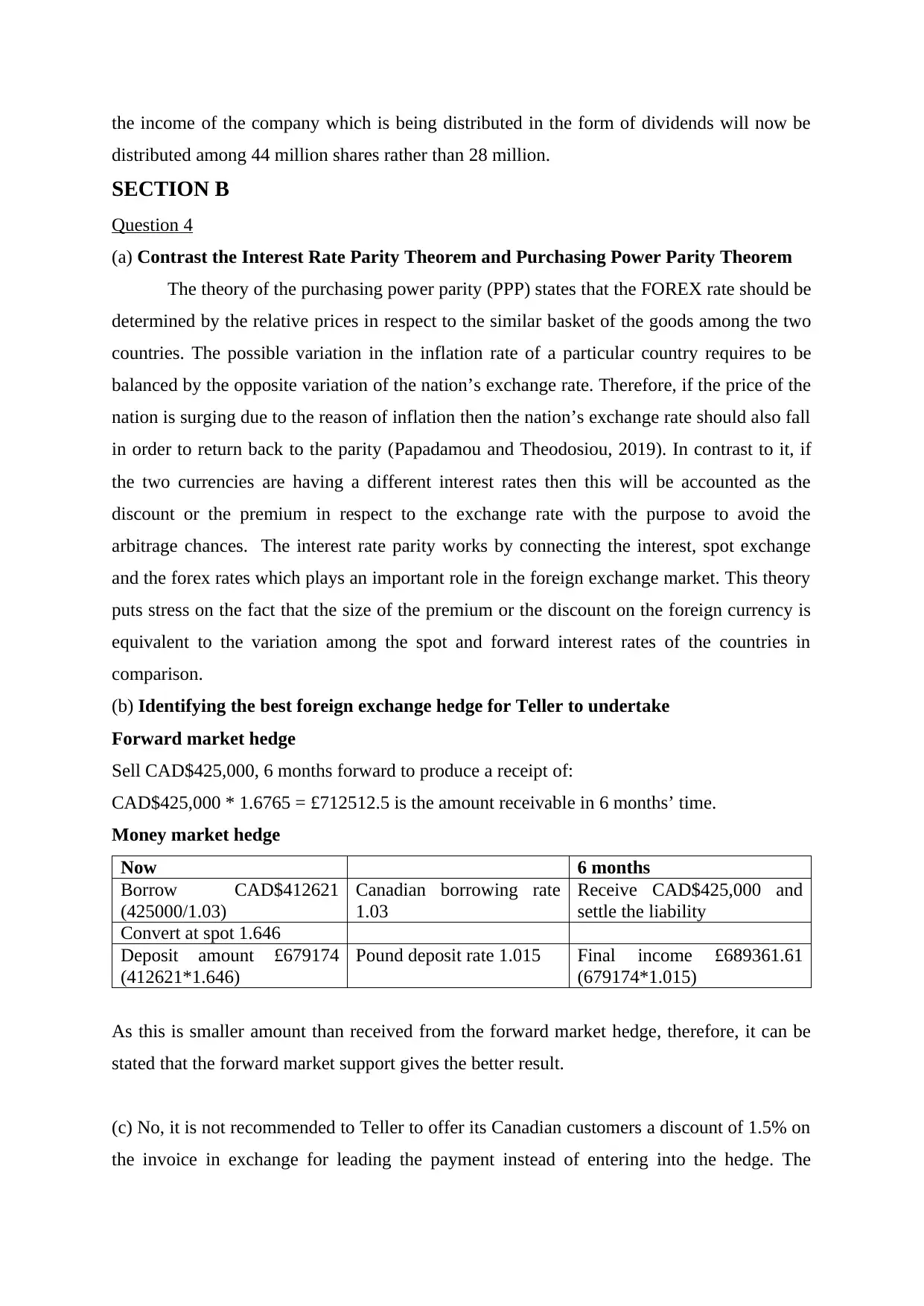
the income of the company which is being distributed in the form of dividends will now be
distributed among 44 million shares rather than 28 million.
SECTION B
Question 4
(a) Contrast the Interest Rate Parity Theorem and Purchasing Power Parity Theorem
The theory of the purchasing power parity (PPP) states that the FOREX rate should be
determined by the relative prices in respect to the similar basket of the goods among the two
countries. The possible variation in the inflation rate of a particular country requires to be
balanced by the opposite variation of the nation’s exchange rate. Therefore, if the price of the
nation is surging due to the reason of inflation then the nation’s exchange rate should also fall
in order to return back to the parity (Papadamou and Theodosiou, 2019). In contrast to it, if
the two currencies are having a different interest rates then this will be accounted as the
discount or the premium in respect to the exchange rate with the purpose to avoid the
arbitrage chances. The interest rate parity works by connecting the interest, spot exchange
and the forex rates which plays an important role in the foreign exchange market. This theory
puts stress on the fact that the size of the premium or the discount on the foreign currency is
equivalent to the variation among the spot and forward interest rates of the countries in
comparison.
(b) Identifying the best foreign exchange hedge for Teller to undertake
Forward market hedge
Sell CAD$425,000, 6 months forward to produce a receipt of:
CAD$425,000 * 1.6765 = £712512.5 is the amount receivable in 6 months’ time.
Money market hedge
Now 6 months
Borrow CAD$412621
(425000/1.03)
Canadian borrowing rate
1.03
Receive CAD$425,000 and
settle the liability
Convert at spot 1.646
Deposit amount £679174
(412621*1.646)
Pound deposit rate 1.015 Final income £689361.61
(679174*1.015)
As this is smaller amount than received from the forward market hedge, therefore, it can be
stated that the forward market support gives the better result.
(c) No, it is not recommended to Teller to offer its Canadian customers a discount of 1.5% on
the invoice in exchange for leading the payment instead of entering into the hedge. The
distributed among 44 million shares rather than 28 million.
SECTION B
Question 4
(a) Contrast the Interest Rate Parity Theorem and Purchasing Power Parity Theorem
The theory of the purchasing power parity (PPP) states that the FOREX rate should be
determined by the relative prices in respect to the similar basket of the goods among the two
countries. The possible variation in the inflation rate of a particular country requires to be
balanced by the opposite variation of the nation’s exchange rate. Therefore, if the price of the
nation is surging due to the reason of inflation then the nation’s exchange rate should also fall
in order to return back to the parity (Papadamou and Theodosiou, 2019). In contrast to it, if
the two currencies are having a different interest rates then this will be accounted as the
discount or the premium in respect to the exchange rate with the purpose to avoid the
arbitrage chances. The interest rate parity works by connecting the interest, spot exchange
and the forex rates which plays an important role in the foreign exchange market. This theory
puts stress on the fact that the size of the premium or the discount on the foreign currency is
equivalent to the variation among the spot and forward interest rates of the countries in
comparison.
(b) Identifying the best foreign exchange hedge for Teller to undertake
Forward market hedge
Sell CAD$425,000, 6 months forward to produce a receipt of:
CAD$425,000 * 1.6765 = £712512.5 is the amount receivable in 6 months’ time.
Money market hedge
Now 6 months
Borrow CAD$412621
(425000/1.03)
Canadian borrowing rate
1.03
Receive CAD$425,000 and
settle the liability
Convert at spot 1.646
Deposit amount £679174
(412621*1.646)
Pound deposit rate 1.015 Final income £689361.61
(679174*1.015)
As this is smaller amount than received from the forward market hedge, therefore, it can be
stated that the forward market support gives the better result.
(c) No, it is not recommended to Teller to offer its Canadian customers a discount of 1.5% on
the invoice in exchange for leading the payment instead of entering into the hedge. The
⊘ This is a preview!⊘
Do you want full access?
Subscribe today to unlock all pages.

Trusted by 1+ million students worldwide
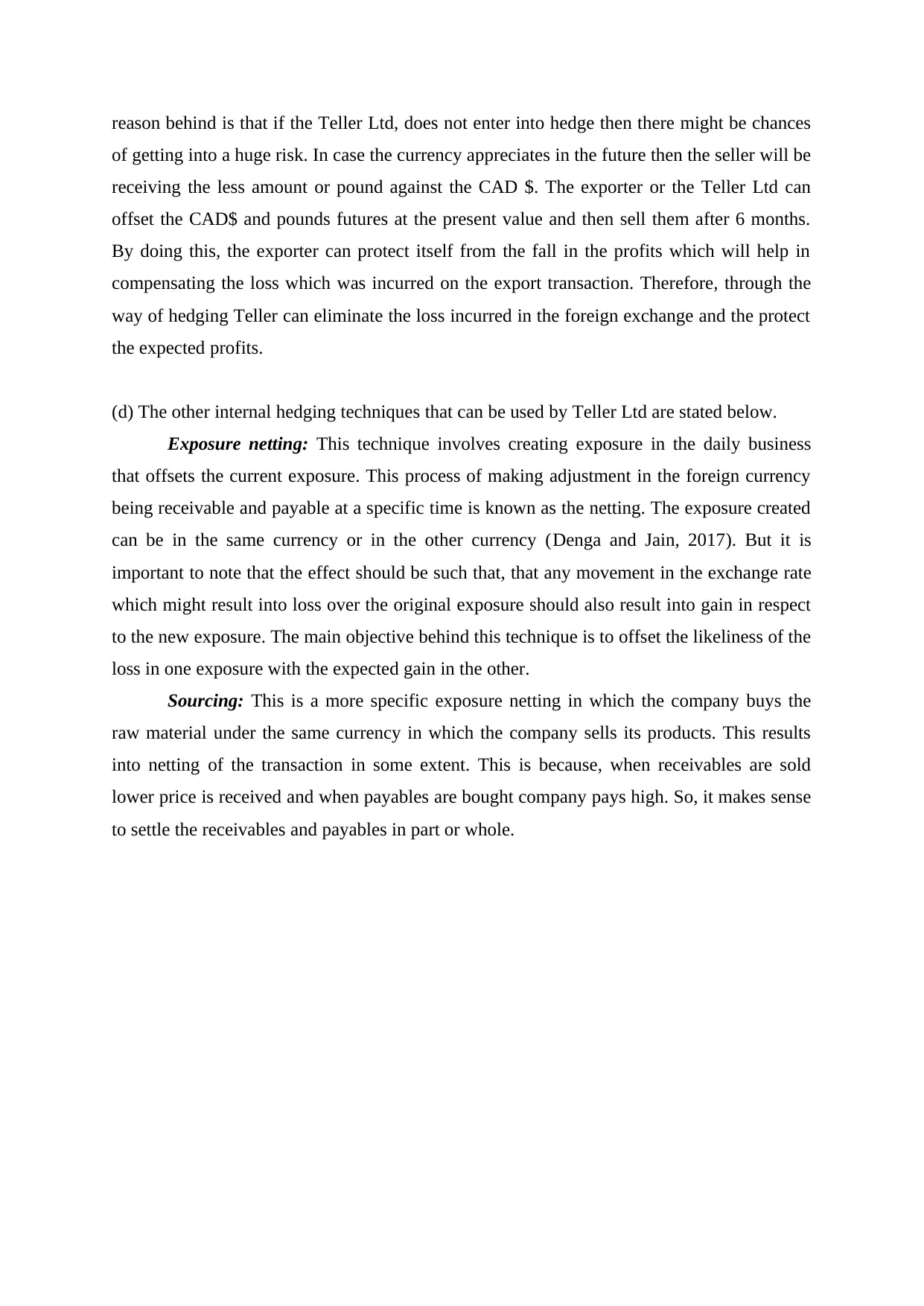
reason behind is that if the Teller Ltd, does not enter into hedge then there might be chances
of getting into a huge risk. In case the currency appreciates in the future then the seller will be
receiving the less amount or pound against the CAD $. The exporter or the Teller Ltd can
offset the CAD$ and pounds futures at the present value and then sell them after 6 months.
By doing this, the exporter can protect itself from the fall in the profits which will help in
compensating the loss which was incurred on the export transaction. Therefore, through the
way of hedging Teller can eliminate the loss incurred in the foreign exchange and the protect
the expected profits.
(d) The other internal hedging techniques that can be used by Teller Ltd are stated below.
Exposure netting: This technique involves creating exposure in the daily business
that offsets the current exposure. This process of making adjustment in the foreign currency
being receivable and payable at a specific time is known as the netting. The exposure created
can be in the same currency or in the other currency (Denga and Jain, 2017). But it is
important to note that the effect should be such that, that any movement in the exchange rate
which might result into loss over the original exposure should also result into gain in respect
to the new exposure. The main objective behind this technique is to offset the likeliness of the
loss in one exposure with the expected gain in the other.
Sourcing: This is a more specific exposure netting in which the company buys the
raw material under the same currency in which the company sells its products. This results
into netting of the transaction in some extent. This is because, when receivables are sold
lower price is received and when payables are bought company pays high. So, it makes sense
to settle the receivables and payables in part or whole.
of getting into a huge risk. In case the currency appreciates in the future then the seller will be
receiving the less amount or pound against the CAD $. The exporter or the Teller Ltd can
offset the CAD$ and pounds futures at the present value and then sell them after 6 months.
By doing this, the exporter can protect itself from the fall in the profits which will help in
compensating the loss which was incurred on the export transaction. Therefore, through the
way of hedging Teller can eliminate the loss incurred in the foreign exchange and the protect
the expected profits.
(d) The other internal hedging techniques that can be used by Teller Ltd are stated below.
Exposure netting: This technique involves creating exposure in the daily business
that offsets the current exposure. This process of making adjustment in the foreign currency
being receivable and payable at a specific time is known as the netting. The exposure created
can be in the same currency or in the other currency (Denga and Jain, 2017). But it is
important to note that the effect should be such that, that any movement in the exchange rate
which might result into loss over the original exposure should also result into gain in respect
to the new exposure. The main objective behind this technique is to offset the likeliness of the
loss in one exposure with the expected gain in the other.
Sourcing: This is a more specific exposure netting in which the company buys the
raw material under the same currency in which the company sells its products. This results
into netting of the transaction in some extent. This is because, when receivables are sold
lower price is received and when payables are bought company pays high. So, it makes sense
to settle the receivables and payables in part or whole.
Paraphrase This Document
Need a fresh take? Get an instant paraphrase of this document with our AI Paraphraser
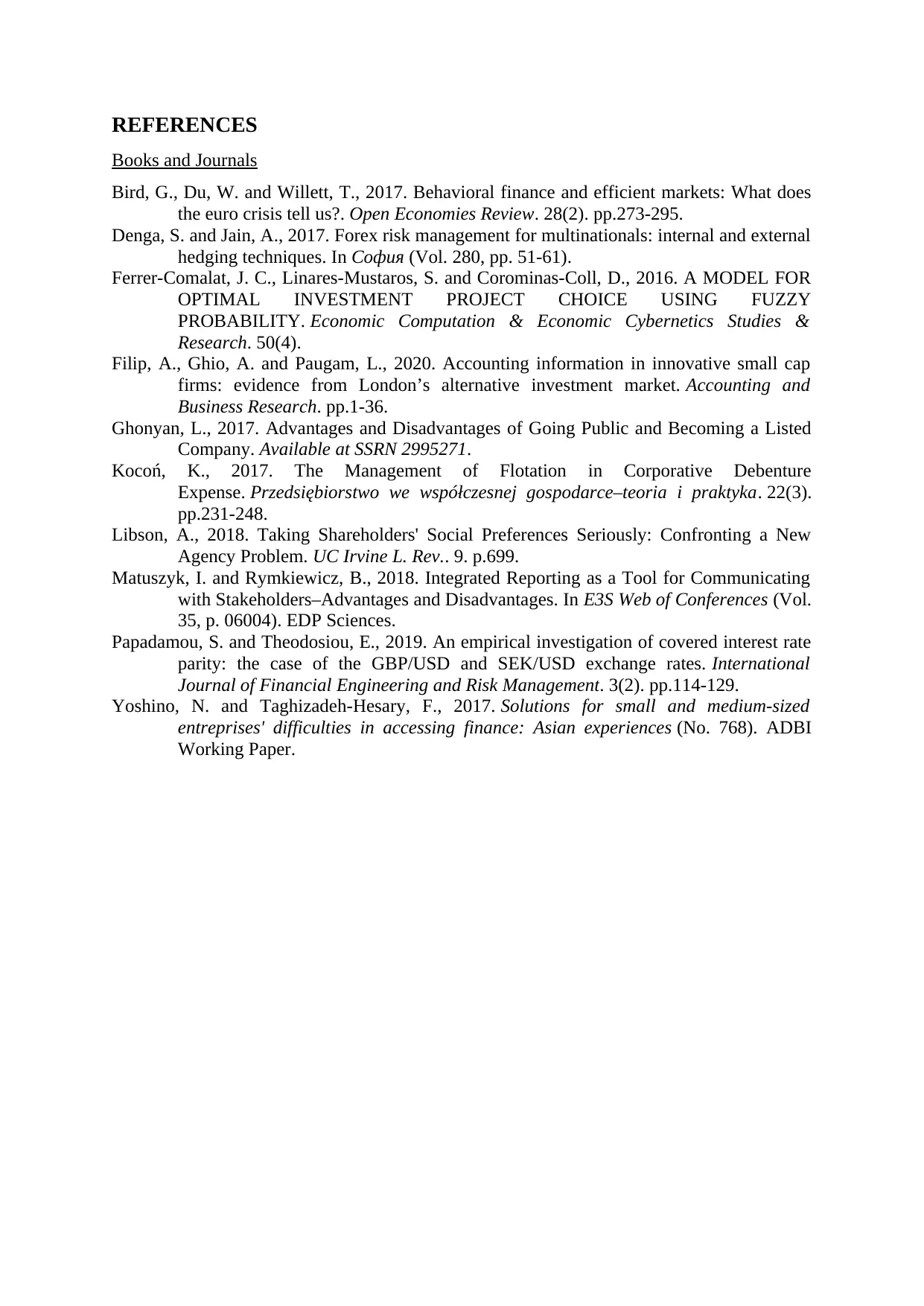
REFERENCES
Books and Journals
Bird, G., Du, W. and Willett, T., 2017. Behavioral finance and efficient markets: What does
the euro crisis tell us?. Open Economies Review. 28(2). pp.273-295.
Denga, S. and Jain, A., 2017. Forex risk management for multinationals: internal and external
hedging techniques. In София (Vol. 280, pp. 51-61).
Ferrer-Comalat, J. C., Linares-Mustaros, S. and Corominas-Coll, D., 2016. A MODEL FOR
OPTIMAL INVESTMENT PROJECT CHOICE USING FUZZY
PROBABILITY. Economic Computation & Economic Cybernetics Studies &
Research. 50(4).
Filip, A., Ghio, A. and Paugam, L., 2020. Accounting information in innovative small cap
firms: evidence from London’s alternative investment market. Accounting and
Business Research. pp.1-36.
Ghonyan, L., 2017. Advantages and Disadvantages of Going Public and Becoming a Listed
Company. Available at SSRN 2995271.
Kocoń, K., 2017. The Management of Flotation in Corporative Debenture
Expense. Przedsiębiorstwo we współczesnej gospodarce–teoria i praktyka. 22(3).
pp.231-248.
Libson, A., 2018. Taking Shareholders' Social Preferences Seriously: Confronting a New
Agency Problem. UC Irvine L. Rev.. 9. p.699.
Matuszyk, I. and Rymkiewicz, B., 2018. Integrated Reporting as a Tool for Communicating
with Stakeholders–Advantages and Disadvantages. In E3S Web of Conferences (Vol.
35, p. 06004). EDP Sciences.
Papadamou, S. and Theodosiou, E., 2019. An empirical investigation of covered interest rate
parity: the case of the GBP/USD and SEK/USD exchange rates. International
Journal of Financial Engineering and Risk Management. 3(2). pp.114-129.
Yoshino, N. and Taghizadeh-Hesary, F., 2017. Solutions for small and medium-sized
entreprises' difficulties in accessing finance: Asian experiences (No. 768). ADBI
Working Paper.
Books and Journals
Bird, G., Du, W. and Willett, T., 2017. Behavioral finance and efficient markets: What does
the euro crisis tell us?. Open Economies Review. 28(2). pp.273-295.
Denga, S. and Jain, A., 2017. Forex risk management for multinationals: internal and external
hedging techniques. In София (Vol. 280, pp. 51-61).
Ferrer-Comalat, J. C., Linares-Mustaros, S. and Corominas-Coll, D., 2016. A MODEL FOR
OPTIMAL INVESTMENT PROJECT CHOICE USING FUZZY
PROBABILITY. Economic Computation & Economic Cybernetics Studies &
Research. 50(4).
Filip, A., Ghio, A. and Paugam, L., 2020. Accounting information in innovative small cap
firms: evidence from London’s alternative investment market. Accounting and
Business Research. pp.1-36.
Ghonyan, L., 2017. Advantages and Disadvantages of Going Public and Becoming a Listed
Company. Available at SSRN 2995271.
Kocoń, K., 2017. The Management of Flotation in Corporative Debenture
Expense. Przedsiębiorstwo we współczesnej gospodarce–teoria i praktyka. 22(3).
pp.231-248.
Libson, A., 2018. Taking Shareholders' Social Preferences Seriously: Confronting a New
Agency Problem. UC Irvine L. Rev.. 9. p.699.
Matuszyk, I. and Rymkiewicz, B., 2018. Integrated Reporting as a Tool for Communicating
with Stakeholders–Advantages and Disadvantages. In E3S Web of Conferences (Vol.
35, p. 06004). EDP Sciences.
Papadamou, S. and Theodosiou, E., 2019. An empirical investigation of covered interest rate
parity: the case of the GBP/USD and SEK/USD exchange rates. International
Journal of Financial Engineering and Risk Management. 3(2). pp.114-129.
Yoshino, N. and Taghizadeh-Hesary, F., 2017. Solutions for small and medium-sized
entreprises' difficulties in accessing finance: Asian experiences (No. 768). ADBI
Working Paper.
1 out of 11
Related Documents
Your All-in-One AI-Powered Toolkit for Academic Success.
+13062052269
info@desklib.com
Available 24*7 on WhatsApp / Email
![[object Object]](/_next/static/media/star-bottom.7253800d.svg)
Unlock your academic potential
Copyright © 2020–2025 A2Z Services. All Rights Reserved. Developed and managed by ZUCOL.





